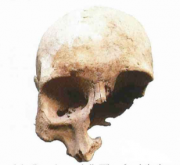78: The Rumahanga Skull
- IJ
- Nov 25, 2016
- 3 min read

In 2004 a skull found on the banks of the Ruamahunga River in the Wairarapa by Sam Tobin who was walking his dog. It turned out to be a Caucasian woman who died about 100 years before the area was settled by Europeans. It was found she was between 40 and 45 years old and died between 266 and 302 years ago. "This suggests that the deceased may have been alive somewhere in the South Wairarapa in or about 1742," said Masterton coroner John Kershaw.
The skull was consequently subjected to a round of DNA and aging tests that unequivocally confirmed the remains to be from a European woman aged from 40 to 45 years old who was "well and truly alive in New Zealand's prehistoric period from about 1619 to 1689". Dr Watt said yesterday the skull represents the first tangible evidence of a European living here before the arrival of Captain James Cook, who first circumnavigated New Zealand in 1769, and "very probably, we're not talking possibly" before explorer Abel Tasman, who first sighted the northwest coast of South Island in 1642.
The coroner noted in his findings that despite radiocarbon dating by GNS Science indicating the woman was alive in 1742, historians said the Wairarapa was not settled by Europeans until after the New Zealand Company sent settlers to Wellington a century later in 1840. Whalers came ashore in the late 1780s. So what was Dr Watt's explanation for a woman in her 40's wandering in Wairarapa during the early 1700s?
In the end, the carbon-dating put the skull's origin at between 1619 and 1689 overlapping with and pre-dating visits to New Zealand by Abel Tasman in 1642 and Captain James Cook in 1769. At this time there was a tremendous amount of movement by the Dutch. We know they were exploring the southern coast of Australia. Anything sailing this way has a chance of being stopped by New Zealand, so for my money there was either a visit here or a wreck. A Dutch ship could have been on a voyage of settlement, rather than discovery, and heading for what is now Indonesia. When they came out, the local governors, dignitaries and the people brought their families...and who was with them? Their wives!
The European discovery of New Zealand was by Abel Janszoon Tasman in December 1642, and history records the first two white women to arrive in New Zealand as Kathleen Hagerty, and Charlotte Edgar, two convicts who escaped from New South Wales and arrived on this side of the Tasman in 1806. Mr Kershaw said there were few facts available.
Two Auckland forensic pathologists Dr Rex Ferris and Dr Tim Koelmeyer said the skull was an adult female, but was not Maori, and was probably Caucasian. You can tell it's not Ploynesian by the shape of the skull (I wonder what the skulls on our skeletons will reveal?). A Wellington forensic pathologist, Dr Robin Watt, said the woman was probably of European origin, aged 40-45, but he could not discount the possibility of Maori ancestry. Masterton archivist Gareth Winter said there were no European inhabitants in the area 300 years ago. Abel Tasman only journeyed along the west coast of the country and did not land anywhere in the North Island. And there were no records of a ship missing in NZ waters during this period. English explorer Captain James Cook, visited Cape Palliser early in 1770. Mr Winter noted that whalers used to visit the Wairarapa coast, but records of their activities were very rare.
What this proves is that Europeans were capable of reaching NZ before any known recorded landing such as in James Cooks time. We know this because if the Endeavor sank on the way home, there would have been no record of his arrival and yet we know he did arrive because he managed to return to England. A bit obvious I know, but consider this... If Indian or Asian ships were more prevalent in the Pacific or Indian oceans there is every possibility wrecks could have occurred here and survivors breeding with the local population produced distinctions in skin, hair and eye colour.
Now here is something else, below is a European skull found in Taree, Australia that dates to well before the first European arrival...in fact somewhere about the mid 1600's. http://www.australiangeographic.com.au/news/2013/07/ancient-skull-from-nsw-could-rewrite-history

Could Europeans have been here before the official recorded arrivals? Absolutely. Many could have been shipwrecked on these shores while back home (in Europe or elsewhere) they were presumed lost at sea!
After all the only reason we know Capt Cook arrived here was that he made it back - right? So what of those that didn't make it back. Does that mean they never arrived?





















































Comments